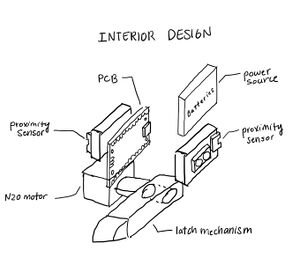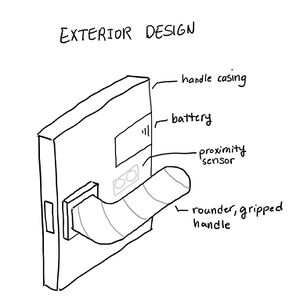
Current door handles seen in most homes require a twisting force from a human hand to unlock the door. The issue that arises from this aging, standard latch mechanism in the handle designed centuries ago is that it's no longer user friendly to a certain demographic of the population. These are people who suffer from Arthritis and Carpal Tunnel Syndrome affects their ability to exert repetitive and straining movements in their joints make it difficult for them to open door handles.
The purpose of this personal project is to investigate a more human-centric and innovative design of a door handle that eliminates the harsh twisting motion required by automating it using a proximity sensor, motor-powered mechanism.
Problem[edit | edit source]
Through chatting with family members living with those who experience pain in their hand/wrist, loss of mobility in the hand, or loss of grip strength as a result of common conditions like Arthritis and Carpal Tunnel Syndrome, many pain points about current door handle designs surfaces. The biggest ones being discomfort and pain. The solutions for this problem currently is to purchase a door handle extension that can be added on to existing handles to decrease twisting force, have a caregiver to help them open the door, and to leave the doors open all the time. However, these extensions can still be uncomfortable for the user as some sort of twisting is involved with the hands. Not everyone is fortunate enough to have a caregiver present to assist them, and leaving all the doors open around the house is not a viable long-term solution.
Three main objectives were chosen based on feedback from a mobility device store located in London Ontario, that shared what their customers value in a solution to a problem like this one.
- First is comfortability through reducing repetitive pain, which is one of the top 3 motivators for living a healthier and more fulfilling life as pain is difficult to bear daily, especially for a long period of time as Arthritis is an incurable condition. The user would most likely be living with this problem for the rest of their life.
- Second is it's easy to implement into the user's home and does not require a lot to maintain. This makes the solution more convenient.
- Third is to ensure the design fosters independence so the user does not need to rely on a caregiver to assist them and that they can feel a great sense of autonomy.
That's where the Automated Door Handle comes in.
Solution[edit | edit source]
Presented as a more innovative and human-centric solution, the Automated Door Handle redefines the meaning of opening doors for those who experience pain in their hands, loss of mobility, and loss of grip strength due to hand-affecting conditions and automates door opening using a proximity censored, motor-powered mechanism. This is to help eliminate the harsh twisting and turning motion required to open home door knobs like the ones used for your bedrooms, closets, and bathrooms.
How it works[edit | edit source]
Through multiple consultations with engineering students and one working for National Research Council Canada, a possible design approach is to have an N20 motor-powered latch that will automatically unlock the door when a proximity sensor (more specifically a digital distance interrupter) near the handle detects a hand reaching for the door. The motor will be connected to a battery power supply of standard size AA single cell cylindrical batteries stored in a compartment within the handle with a ribbon that allows for easy battery take-out for replacements. To connect all electrical components together, a unique PCB will need to be manufactured. That way, all the user needs to do is pull the handle to open the door without inducing most of the stress on the hands caused by twisting the handle which promotes self-sufficiency of accessing different parts of the house on their own.


It should be noted that the battery supply is still being developed as using single cell batteries poses an issue of requiring monthly maintenance to ensure the door does not run out of battery and stop working which could prevent the door from opening altogether. A backup door unlocking method for situations like this should be considered such as adding an extra key hole.
A more human-centric design to the Automated Door Handle is adding a cushion-like grip tape layer over the handle to enhance comfortability by thickening the handle width and creating rounder edges in tangent with increasing grip to prevent the hands from slipping off a typical smooth handle finish.
The BOM of the Automated Door Handle is detailed below.
| Item | Units | Cost |
| Latch Mechanism | 1 | - |
| N20 Motor | 1 | $3.00 |
| Latch to Motor Adapter | 1 | $0.20 |
| Proximity Sensor | 2 | $6.00 |
| PCB | 1 | $5.00 |
| Battery Source | 1 | $3.00 |
| Door Handle Casing | 1 | $2.00 |
| Grip Tape | 1 | $0.75 |
| Handle | 2 | $16.00 |
| Shipping Costs | - | $12.00 |
| Labor | - | $15.00 |
| Tax | - | $8.18 |
| Total Product Cost | $71.13 |
A huge issue to tackle is the substantial costs associated with a design that involves numerous materials. Most of these parts are bought at retail prices which greatly drives up overall costs. An alternative is to 3D print items such as handles and door handle casing which has a lower manufacturing cost as well as buying in bulk. Another form of cost reduction in the midst of development is the option to create a mechanism that works in conjunction with the user's existing latch mechanism in their homes so they do not need to replace their entire door handle. This would also help ease the installation process. A possible idea to consider is creating multiple latch-to-motor adapters that can connect any latch to the N20 motor via a 3D printed connecter and the user can choose which one works with their door.
Next steps[edit | edit source]
- Create a 3D model of the design to get a better visualization of how the mechanism works
- Continue to streamline material costs like researching more ways to build the parts in house
- Gather feedback from target users to make further improvements towards the design and functionality
Importance of this project[edit | edit source]
This personal project was pursued in hopes of adding value to those who experience pain and discomfort in their hands on a daily basis and ultimately prevent them from living the life they desire. As one who also suffers from a long-term condition, I can personally say how much it would mean to me to have other people care about my condition, to learn and understand how it affects my day-to-day life, and to help create a solution for some of my pain points. So far, it has been very fulfilling to work on this project. At first in hopes of turning this idea into reality and applying to the Western Morrissette Institute of Technology's Entrepreneurship Summer Internship Program. After making it through only one of the two application rounds, I realized there is still lots of growth and logistics in this idea that need to be solidified from the feedback received from the judges. Although it is still a growing idea today, I believe there is still potential in innovating home door handles to address the pain points of utility and comfort amongst the Arthritis and Carpal Tunnel Syndrome community.
References[edit | edit source]
- Arthritis of the hand - orthoinfo - aaos. OrthoInfo. (n.d.). Retrieved March 23, 2022, from https://orthoinfo.aaos.org/en/diseases--conditions/arthritis-of-the-hand/
- Mintel. (n.d.). (publication). Seniors and Health - US - December 2018.